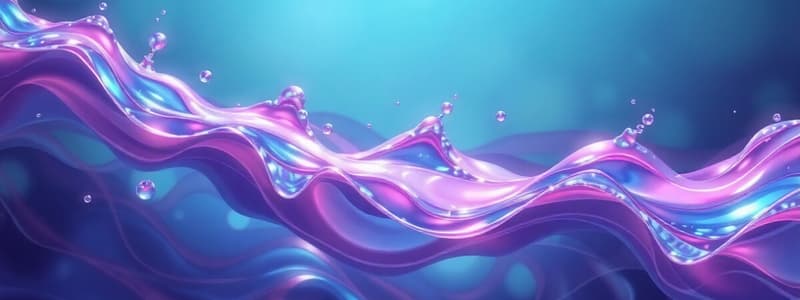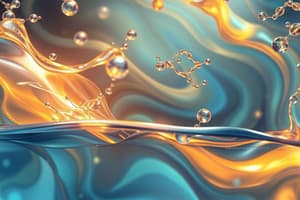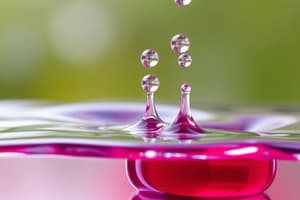Podcast
Questions and Answers
Surface tension is a phenomenon that occurs because of cohesive forces between liquid __________.
Surface tension is a phenomenon that occurs because of cohesive forces between liquid __________.
molecules
Viscosity is a quantity that describes a fluid's resistance to __________.
Viscosity is a quantity that describes a fluid's resistance to __________.
flow
Capillarity refers to how a liquid can rise or fall in a small space due to intermolecular __________.
Capillarity refers to how a liquid can rise or fall in a small space due to intermolecular __________.
forces
The boiling point is the temperature at which vapor pressure equals the surrounding __________ pressure.
The boiling point is the temperature at which vapor pressure equals the surrounding __________ pressure.
Amorphous solids, also known as pseudo solids, do not have a repeating lattice __________.
Amorphous solids, also known as pseudo solids, do not have a repeating lattice __________.
Covalent solids are bonded in a continuous network, resulting in __________ crystals.
Covalent solids are bonded in a continuous network, resulting in __________ crystals.
Molecular solids are held together by electrostatic forces known as __________ forces.
Molecular solids are held together by electrostatic forces known as __________ forces.
The energy required to transform a substance from liquid into gas is known as the molar heat of __________.
The energy required to transform a substance from liquid into gas is known as the molar heat of __________.
Flashcards
Surface Tension
Surface Tension
The phenomenon where cohesive forces between liquid molecules cause the liquid to resist external forces.
Viscosity
Viscosity
A measure of a fluid's resistance to flow; also called dynamic or absolute viscosity.
Kinematic Viscosity
Kinematic Viscosity
A fluid's resistance to flow under the influence of gravitational forces.
Capillarity
Capillarity
Signup and view all the flashcards
Vapor Pressure
Vapor Pressure
Signup and view all the flashcards
Boiling Point
Boiling Point
Signup and view all the flashcards
Molar Heat of Vaporization
Molar Heat of Vaporization
Signup and view all the flashcards
Covalent Solids
Covalent Solids
Signup and view all the flashcards
Study Notes
Properties of Liquids
- Liquids have a definite volume but no definite shape.
- Liquids take the shape of their container.
- Liquids are relatively incompressible.
- Adhesion: Attraction between different molecules. An example is tape sticking to paper.
- Cohesion: Attraction between like molecules. An example is Mercury forming beads.
- Surface Tension: A phenomenon where liquid molecules resist an external force due to cohesive forces.
- Viscosity: A measure of a fluid's resistance to flow. High viscosity means strong intermolecular forces (IMF), while low viscosity implies weaker IMFs. An example of high viscosity is honey, and water has low viscosity.
- Capillarity: The ability of a liquid to flow in narrow spaces without the assistance of, or even in opposition to, external forces like gravity. This is caused by interactions between the liquid molecules and the surface of the container (adhesion forces) being stronger than the cohesive forces between the liquid molecules themselves.
- Capillary rise depends on the narrowness of the tube.
- Vapor Pressure: The pressure exerted by a gas/vapor in equilibrium with its liquid or solid phase in a closed system at a given temperature.
- Boiling Point: The temperature at which the vapor pressure of a liquid equals the surrounding atmospheric pressure. Different substances have different boiling points.
- Molar Heat of Vaporization: The energy needed to transform a given amount of liquid into gas at a set pressure.
Structure and Properties of Water
- Water molecules are polar, with a slightly negative oxygen end (δ-) and two slightly positive hydrogen ends (δ+).
- Hydrogen bonding occurs between the δ- end of one water molecule and the δ+ ends of other water molecules. This explains many unique properties of water.
Solids
- Solids maintain a definite shape and volume.
- Solids resist compression.
- Solids generally do not diffuse into other solids.
- Solids do not flow. Solids can be stored in containers.
- When heating solid change into liquid.
Crystalline and Amorphous Solids
- Crystalline solids: Possess highly ordered atomic arrangements forming well-defined structures.
- Amorphous solids: Lack long-range order in their atomic or molecular arrangement. The arrangement is random and disordered.
Types of Crystalline Solids
- Ionic solids: Composed of positively and negatively charged ions held together by strong electrostatic forces (ionic bonds). Examples include NaCl (sodium chloride) and MgO (magnesium oxide).
- Metallic solids: Composed of metal atoms arranged in regular lattice structures held together by metallic bonds (delocalized electrons). Examples include Au (gold) and Al (aluminum).
- Covalent solids: Atoms are covalently bonded in a continuous network structure. These solids are extremely hard and have very high melting points. Examples include diamond.
- Molecular solids: Consist of covalently bonded molecules attracted to each other by weak intermolecular forces (Van der Waals forces). Examples include carbon dioxide (CO2) and iodine (I2).
Properties of Metallic Solids
- Opaque and lustrous appearance.
- Malleable and ductile.
- Good conductors of heat and electricity due to delocalized electrons.
- High melting points (except for mercury and phosphorus).
Studying That Suits You
Use AI to generate personalized quizzes and flashcards to suit your learning preferences.




